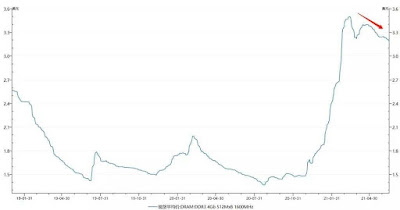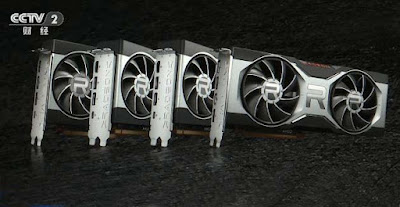Virtual currencies mining consumes chips, so the global shortage of chips is Bitcoin's fault? This may not be the case.
Determined to refrain from Bitcoin or any other virtual currency, I thought that all the fuss over cryptocurrencies had nothing to do with me. The painful truth is that as Bitcoin fell, Micron and other chip stocks seemed to follow.
Since Bitcoin hit a high of $63,518 in April, it has started to fall all the way, and is currently standing at around $38,000. At the same time, DRAM prices began to fall almost simultaneously.
The price index of 4GB DDR3, which is composed of 8 512M DRAM particles, began to fall after the high point in March, which is very similar to the price trend of Bitcoin.
DRAM prices rise with Bitcoin?
Then looking forward again, the last wave of Bitcoin's bull market started in September 2017, and it doubled by 5 times in December, with the price rising from $3,500 to $19,000. The price of DRAM also rose again after the consolidation in June-September 2017, and peaked at the same time as the price of Bitcoin in December, and also fell at the same time.
Bitcoin's production rules also seem to illustrate a point.
When Satoshi Nakamoto created Bitcoin in 2008, he set a very important rule: Regardless of the mining power of the entire network, the Bitcoin network "rewarded" Bitcoin every 10 minutes.
Under this rule, if you want to get more bitcoins, you can only increase the proportion of your own computing power in the entire network. For example, the current computing power of the entire network is 127EH/s, and EH/s is the unit, which represents 10 to the 18th power of hash calculation per second.
At present, the most powerful mining machine has a computing power of about 111TH/s, which is equivalent to one millionth of the computing power of the entire network. One millionth of the Bitcoin reward.
The current Bitcoin network rewards each time is 6.5 Bitcoins, excluding the handling fee. According to the latest Bitcoin price of 38,000 US dollars, the reward for the entire network in one year is about 13 billion US dollars, which is approximately 81.78 billion yuan.
Then, the most powerful mining machine in the whole network, the annual return is about 70,000 yuan. After deducting the cost of electricity, the annual profit is also more than 60,000 yuan. And such a mining machine is only a little over 20,000 yuan, and it can pay back in less than half a year. Isn't everyone going to roll up such a good business? Just like the Hong Kong stock market is new, the Bitcoin mining market is getting more and more volume, computing power has become an arms race, and the computing power of the entire network has increased by nearly 140 times in the past five years.
The most powerful mining machine mentioned abobe -Bitmain's latest S19Pro, is equipped with 114 ASIC chips, which is hard to beat by ordinary home computers.
In the early years, we could also use our own computers to mine, but if you want to do this today, you may need to spend 2016 to mine a bitcoin.
Therefore, as long as Bitcoin continues to rise, there will still be profit margins for mining. Then there will be countless miners who will continue to roll up and pile up machines, and the sales of chips will also rise steadily.
Bitcoin is to blame for the global shortage of Chips?
Mining consumes chips, so this time the global shortage of cores, is it all Bitcoin's pot? This may not be the case.
According to the current Bitcoin network computing power of 127EH/s, we assume that the average computing power of the mining machine is 60-80TH/s (calculation level a year ago), regardless of other network card mining, then the mining machine of the whole network is probably There are 1.6 million-2.11 million units.
The depreciation time of mining machines is about 1-2 years. It is not that these machines are easily scrapped. It is just that the computing power of 2 years ago may not be able to earn back even the electricity bills. Based on this estimate, 1 to 1.5 million mining machines have been sold each year in the past two years.
According to a mining machine with 100 ASIC chips and 32GB, the chip demand for the mining machine is about 100 million to 150 million, and the demand for 512MB DRAM particles is about 100 million.
Compared with other digital products, these needs are insignificant!
According to data from the well-known semiconductor material manufacturer SUMCO, the top three downstream applications of 12-inch wafers in 2020 are smartphones, PCs/tablets and servers, and the proportions of 8-inch wafers downstream applications are automotive, industrial, and PC/tablets.
From a demand perspective, with the exception of PCs and tablets, which rose sharply, other digital products markets were relatively flat.
In 2020, global notebook shipments will be around 200 million units, and tablet PC shipments will be 164 million units, an increase of 37 million and 20 million units respectively compared to 2019.
In terms of servers, according to IDC's data, 3.1 million and 3.3 million units were sold in the third and fourth quarters of last year. The annual sales volume was about 12 million, which was not much different from the previous year.
In terms of mobile phones, due to the decline in the first and second quarters of last year, the annual sales even went backwards. According to IDC data, global mobile phone shipments will be 1.28 billion units in 2020, a decrease of 78 million units compared to 2019.
So how much production capacity of chips does the demand for these digital products take up?
Take DRAM as an example. From the perspective of JD.com, the current mainstream notebook configurations on the market, such as the Lenovo Xiaoxin series, are basically Intel CPUs with 16GB of memory. The better models will also be equipped with NVIDIA's discrete graphics cards.
If a notebook computer is calculated at 16GB, the memory of the mobile phone is about 8GB, and the standard configuration of the server is about 32GB. According to the scale mentioned above, the memory resources consumed by PCs/tablets, mobile phones and servers in 2020 will be about 15 billion GB.
The memory sticks we usually use are generally assembled from DRAM chips, such as a 4GB memory stick with 8 512MB DRAM chips mounted on it.
Then 15 billion GB corresponds to about 30 billion DRAM chips.
At present, the DRAM chip technology used by Samsung, Micron and other manufacturers is in the process of transitioning from 18nm to 17nm. We assume that these chips are all produced by 18nm technology, and they all come from 12-inch fabs.
According to the general calculation formula of international Fab factories, a 12-inch (300mm) wafer can cut approximately 600 DRAM particles. Calculated at a yield rate of 90%, the output of a wafer is about 540 particles.
So converted, the demand for wafers for mobile phones, PCs, servers, and tablets alone is 4.6 million wafers/month. If you include other demand, the global demand for DRAM alone requires 6.5 million wafers/month. Production.
According to IC Insight data, as of December 2020, the world's top five wafer production capacities are Samsung, TSMC, Micron, SK Hynix and Japan Kioxia, with a total production capacity of 11.16 million wafers per month.
Because these production capacities are not all 12-inch wafer fabs, and besides DRAM, there are many kinds of chips that need to be produced, so overall, the wafer production capacity is still very tight, so it is not difficult to explain why Bitcoin As soon as it rose, there were more people mining, and DRAM began to be out of stock.
And it is not easy to increase wafer production capacity. Samsung, TSMC, and Micron have only increased by 100,000 units/month, 200,000 units/month and 90,000 units/month in 2020.
Bloomberg reported earlier that it would take 3 years for Bosch in Germany to build a fab with a core process of 65nm and processing 12-inch wafers, as well as an investment of 1 billion euros. Samsung’s 10nm process crystals Yuanchang will only invest more.
The interpretation of the future
Historically, it is the most difficult to predict demand for DRAM and even the entire chip industry.
The capital expenditure for wafer production is large, and the product of the chip is standardized. Once the demand forecast is wrong, a large amount of investment will be lost. This is why the chip industry often has companies going bankrupt, and often that kind of cycle comes. The story of chip companies making ten years of money in a year.
Although it is basically impossible to predict future demand, we can make some simple deductions.
Suppose there are three situations: A, B, and C.
Situation A: Demand continues to rise. In the most optimistic scenario, PCs, data centers, mobile phones and even Bitcoin are in a state of strong demand.
Situation B: Demand is flat. There is a phenomenon of staggered peaks between different demands. For example, the demand for PCs has fallen, but the demand for mobile phones has risen, and the overall demand is in a state of sideways.
Situation C: Demand shrinks. Various types of demand have entered a stage of contraction at the same time, and chips have begun to balance supply and demand, or even exceed demand.
Based on the situation in the past few years, the demand for servers is the most stable among the downstream demand for chips. Even under the impact of the new crown epidemic last year, people's home office demand has greatly increased, and the sales of servers have not changed much. Then we can assume that this part of the demand is stable.
Although the demand for notebooks increased sharply last year, the notebook product has a relatively long depreciation period and there is currently no new technology to promote notebook sales. Therefore, the sales volume in 2021 will continue to grow on a high base, and it is not small. The probability of a sideways or decline is greatest.
Finally, the demand for mobile phones is likely to grow. On the one hand, sales declined during the epidemic last year, and on the other hand, it has been in a 5G renewal period in recent years, which may bring about a wave of phone replacement.
Taken together, of the above three cases, case B has the highest probability.
Going back to the stock price of chip stocks, if it is situation A or situation C, it is relatively easy to operate, situation C should avoid chip stocks, situation A is the most favorable for those companies with room for production capacity, like last year's UMC, in strong demand Under the circumstances, both volume and price will rise.
In case B, chip stocks are at best structural market. Among a wide range of chips, there may be a mismatch between chip demand and supply, and there are signs of relative prosperity. In this case, there will also be certain investment opportunities.





No comments:
Post a Comment